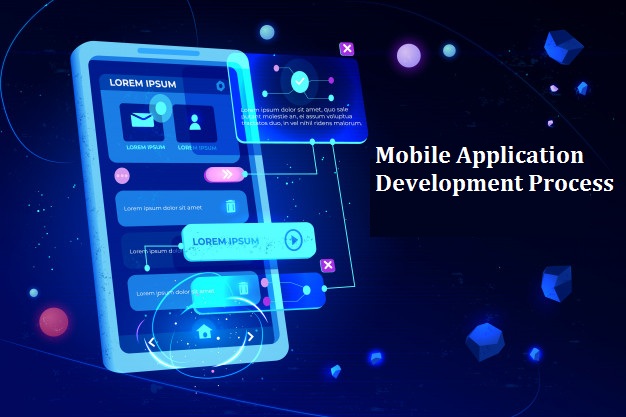Mobile phones have provided us the smart and easy way to conduct the business activities. With the statistics of preceding years it can be clearly stated that the mobile applications have resulted in its escalating utilisation ultimately providing in afresh strategies of mobile application development process to mobile application development companies. It is very important for any mobile application development company to develop the mobile accomplishing the aspirations of the market requirements and market goals. If you are looking for any software Development Company to build up the mobile application in Ahmedabad you can contact DNG web developer. DNG web developer- Ahmedabad would provide you required services with effective outcome of successful mobile application.

Below is the detailed description of the mobile application development process:
Discover the idea:
At the initial level, when you begin to start up development of mobile application, provide the exact and detailed information to developers of your software development company about your project. This might surely result into great discovery of mobile application to be developed.
- Sketching of an idea: The brief sketch of your idea is required to be conducted at the initial stage. To attain the result in the discovery stage many software development companies use Lean Canvas. Lean Canvas is where you can fill up the information of your idea, solution to the problem and much more. It can start as one of the relevant options to organise the idea for its smooth implementation. Lean Canvas provides the required answers to your questions ultimately helping to estimate the further procedure and time required.
- Generate a navigation notion: Navigation notion/idea is a low-fidelity prototype i.e. a group of images to show the connections of the way screens work on the mobile application you are working. This navigation can also assist in estimating the costs i.e. providing a better understanding of the function so that the team can know the cost to develop the same.
Know your idea is valid or not:
Generating an idea is not an issue but it is important to know if the idea generated or designed is valid or not. This validity provides you an assurance that your application development won’t fail. By idea validation you can know the importance or worth of your idea. Now the point is how to know the validity of the idea designed thus there are some methods to know the same.
- Direct research: you can easily know the validity of idea by conducting the direct research in which you are able to directly asking the queries. You can also attain the idea of where you can come up leaving your competitors behind.
- Surveys or research for queries: surveys are again the source of reliable outcome. You can conduct the surveys with your current as well as future customers by allotting you the feedback on the questions provided to them. On the other hand you can conduct the research of your queries. This can result you in providing the solutions to ones who are actually looking for mobile application development.
- Promotions and advertisements: you can get a brief idea of the validation by conducting the advertisements and promotions i.e. by the response to these ads. Social media can become a mediator in providing outcome of the same.
- Validity through prototype: the prototype conducted at the initial stage can help you to know if the idea would achieve the targeted goals or not. You can do it by offering a prototype to a group in any form. You can lessen your risks while the process of mobile application development.
- Create a medium-fidelity prototype: the mobile application development process requires several prototypes to be formed. Medium-fidelity prototypes are little complex than low-fidelity prototypes. This is indirectly a mock-up which provides you n idea of actually working of the application when formed. This type of prototype is less expensive and can be built faster providing you the final version scenario. You can conduct the modifications in your application development in process in order to attain success in the mobile application.
Designing of an application:
After finalising the above two stages you can easily have an idea of what can work properly in the market. Now you can start your designing process by structuring the things cohesively of what you gave collected. After the proper structuring of the data, you can proceed with creation of another mock-up i.e. high-fidelity prototype. User interface (UI) and experience design (UX) are the two chief factors providing you an idea of application development success. UI design gives the visual medium that displays the app to the user while the UX design speaks about way of human interaction with the app. The design of mobile application should be interactive, attractive and engaging as well.
- Creation of Information Architecture and working: in information architecture, the data, functionality and working of an application are determined. This includes information about the concept and the way application fits into the concept.
- Wireframes: UI is in mobile application development process is named as wireframes. It provides main/chief elements of UI such as layout, buttons, icon and much more. It provides details of the application and its visual elements. Wireframes mainly allot a notion of layout, user experience whereas; it does not give the information of colour themes and style.
- Style guide and mock-up: Style guide give the information of mobile application functions as without it developing a standardised application can be less effective. Style guides are all about standards, consistency, its use and much more acting as an important of the designing stage. Mock-ups are high-fidelity design. The wireframes interconnect with style guide standards and provide the connection of various elements of visual design, determining the flow of the app.
- Prototypes: they give an idea of working of an application. Mock-ups are stated as dummy runs of the application while prototypes provide the actual real version of the application. Prototypes can be time-consuming but it provides testing of your app’s design and functionality which can be useful in further process.
- Application development: application development provides the actual scenario and coding. Mobile application development requires developing code and separating the environment in different parts.
- Front-end: in this part the users would be able to see visual design, interface and much more proving an interaction. Programming language is been selected as per the platform on which application is been worked.
- Back-end: back-end is the thing which actually holds everything together, provides operation, manages the communication as a result the mobile application development companies have at least a specialist for the same.
Testing:
Testing assists to know the quality of the application and gives an idea about its accuracy. It is conducted to know the flaws in the application and to solve them. If they are not solved, it may create some technical issues to the same. This is conducted by a separate team. The testing stages are often accompanied by the associated development which focuses to solve the flaws. This phase is ended when all problems are resolved to get an idea of successful application development which is then approved to be launched.
After testing, the product is than further launched in the market. For this, it is to be an application store specifying the application fulfilling the requirements.



1 thought on “Mobile Application Development Process: A Project to Make Successful Application”
Comments are closed.